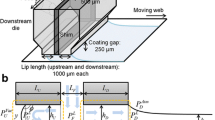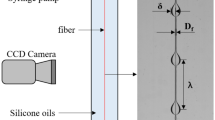Abstract
Slot coating is a popular coating method, in which the film thickness is precisely controlled by adjusting the flow rate and production speed. When the coating flow undergoes small-scale disturbances generated by rotating elements such as motors, pumps, or uneven rolls, the downstream meniscus fluctuates, which causes film thickness variation in the flow direction. Although most coating liquids including polymeric and particulate solutions exhibit a shear-thinning rheological property, their effect on transient coating flow behaviors is not deeply understood. Here, the effect of shear-thinning property on film thickness variation under different disturbances is investigated using a computer-aided analysis of transient slot coating flow. In this study, the Carreau model is used to describe the shear-thinning property, and four different disturbances are considered.








Similar content being viewed by others
References
Carvalho, MS, Kheshgi, HS, “Low-Flow Limit in Slot Coating: Theory and Experiments.” AIChE J., 46 (10) 1907–1917 (2000)
Chang, YR, Chang, HM, Lin, CF, Liu. TJ, Wu, PY, “Three Minimum Wet Thickness Regions of Slot Die Coating.” J. Colloid Interface Sci., 308 (1) 222–230 (2007)
Romero, OJ, Carvalho, MS, “Response of Slot Coating Flows to Periodic Disturbances.” Chem. Eng. Sci., 63 (8) 2161–2173 (2008)
Lee, S, Nam, J, “Analysis of Slot Coating Flow Under Tilted Die.” AIChE J., 61 (5) 1745–1758 (2015)
Perez, EB, Carvalho, MS, “Optimization of Slot-Coating Processes: Minimizing the Amplitude of Film-Thickness Oscillation.” J. Eng. Math., 71 (1) 97–108 (2011)
Tsuda, T, de Santos, JM, Scriven, LE, “Frequency Response Analysis of Slot Coating.” AIChE J., 56 (9) 2268–2279 (2010)
Koh, H, Kwon, I, Jung, H, Hyun, J, “Operability Window of Slot Coating Using Viscocapillary Model for Carreau-Type Coating Liquids.” Korea Aust. Rheol. J., 24 (2) 137–141 (2012)
Bhamidipati, K, Didari, S, Harris, TA, “Experimental Study on Air Entrainment in Slot Die Coating of High-Viscosity, Shear-Thinning Fluids.” Chem. Eng. Sci., 80 195–204 (2012)
Lee, S, Koh, H, Ryu, B, Kim, S, Jung, H, Hyun, J, “Operability Coating Windows and Frequency Response in Slot Coating Flows from a Viscocapillary Model.” Chem. Eng. Sci., 66 (21) 4953–4959 (2011)
Lee, S, Nam, J, “Response of Slot Coating Flow to Gap Disturbances: Effects of Fluid Properties, Operating Conditions, and Die Configurations.” J. Coat. Technol. Res., 12 (5) 949–958 (2015)
Silliman, WJ, Scriven, LE, “Separating Flow Near a Static Contact Line: Slip at a Wall and Shape of a Free Surface.” J. Comput. Phys., 34 287–313 (1980)
Acknowledgments
This research was supported by the Basic Science Research Program through the National Research Foundation of Korea (NRF) funded by the Ministry of Science, ICT & Future Planning (NRF-2016R1D1A1B03931632); and Global Ph.D. Fellowship Program through the National Research Foundation of Korea (NRF) funded by the Ministry of Education (2014H1A2A1019789).
Author information
Authors and Affiliations
Corresponding author
Appendix
Appendix
Development of the parabolic velocity profile for Carreau fluids
To investigate the development of the inlet flow of Carreau fluids, a steady-state Navier–Stokes equation is computed in a parallel plate similar to the feed slot depicted in Fig. 9a. A parabolic velocity profile for the Newtonian fluid is imposed on the inlet. For the CB fluid, velocity profile change in the flow direction is plotted in Fig. 9b. Because the shear stress vanishes at the middle of the flow, the viscosity of the Carreau fluid becomes zero-shear viscosity; hence, the velocity of the fluid decreases. To compensate for the flow rate, the amount of flow increases in the vicinity of the wall. As shown in Fig. 9b, the flow rapidly develops in a short distance from the inlet, e.g., \(0.365\,{\mathrm {mm}}\) for CB. Table 3 shows the critical distance at which the velocity profile does not change further. Because the flow is fully developed within half of the feed height, the parabolic velocity profile at the feed inlet may not affect transient slot coating flow, which is a reasonable choice for the inlet boundary condition for Carreau fluids.
Dependence of film thickness variation on the upstream bead size under vacuum disturbance
As discussed above, the flow response to the vacuum disturbance is not affected by fluid properties. Here, we investigate the most influential parameter: the upstream bead size. For simplicity, the amplification factor is computed using Newtonian fluids.
Figure 10a shows the effect of upstream bead size with constant viscosity. As the upstream bead size increases, \(\alpha\) increases. Meanwhile, Newtonian viscosity does not affect \(\alpha\) as shown in Figs. 10b and 10c. When vacuum pressure is fixed, the meniscus is pulled toward the upstream for the low viscosity of Newtonian fluid because of the low viscous force. Therefore, the difference of \(\alpha\) in Fig. 10b is also caused by the upstream bead size because \(\alpha\) for different viscosity with the same upstream bead size is almost the same (Fig. 10c).
When the upstream bead size is large, or the upstream meniscus location is far from the feed slot, the effect of pressure force due to the inlet flow is reduced. On the contrary, the pressure force due to the vacuum increases, which makes the upstream meniscus fluctuate more (Fig. 11a). Consequently, the pressure gradient oscillation due to the meniscus fluctuation increases, and film thickness variation also increases (Fig. 11). After all, film thickness variations under vacuum disturbance are mainly affected by the upstream bead size.
Amplification factor of vacuum disturbance for Newtonian fluids. Newtonian viscosity is \(\mu =30\,{\mathrm {cP}}\) for (a), and steady-state vacuum pressure is \(P_{\text {vac,0}}=1500\) Pa for (b). For (c), \(P_{\text {vac,0}}\) is set such that the upstream bead size is the same for all three cases
Relationship of (a) the magnitude of dynamic contact line (DCL) \(| \delta x_{\text {dcl}}|\) with upstream bead size \(L_{\text {u}}\) and (b) magnitude of film thickness variation \(| \delta h_{\text {0}}|\) with \(| \delta x_{\text {dcl}}|\) at \(10\,{\mathrm {Hz}}\). The units for \(| \delta x_{\text {dcl}}|\) and \(| \delta h_{\text {0}}|\) are \(\,{\mathrm {mm}}\) and \(\,{\mathrm {\upmu m}}\), respectively
Rights and permissions
About this article
Cite this article
Lee, S., Nam, J. Transient response of slot coating flows of shear-thinning fluids to periodic disturbances. J Coat Technol Res 14, 981–990 (2017). https://doi.org/10.1007/s11998-017-9952-3
Published:
Issue Date:
DOI: https://doi.org/10.1007/s11998-017-9952-3







